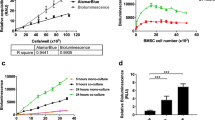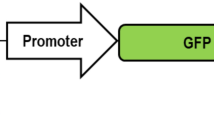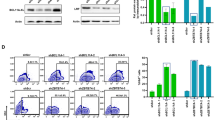Abstract
Expression of multiple genes from the same target cell is required in several technological and therapeutic applications such as quantitative measurements of promoter activity or in vivo tracking of stem cells. In spite of such need, reaching independent and high-level dual-gene expression cannot be reliably accomplished by current gene transfer vehicles. To address this issue, we designed a lentiviral vector carrying two transcriptional units separated by polyadenylation, terminator and insulator sequences. With this design, the expression level of both genes was as high as that yielded from lentiviral vectors containing only a single transcriptional unit. Similar results were observed with several promoters and cell types including epidermal keratinocytes, bone marrow mesenchymal stem cells and hair follicle stem cells. Notably, we demonstrated quantitative dynamic monitoring of gene expression in primary cells with no need for selection protocols suggesting that this optimized lentivirus may be useful in high-throughput gene expression profiling studies.
This is a preview of subscription content, access via your institution
Access options
Subscribe to this journal
Receive 12 print issues and online access
$259.00 per year
only $21.58 per issue
Buy this article
- Purchase on Springer Link
- Instant access to full article PDF
Prices may be subject to local taxes which are calculated during checkout







Similar content being viewed by others
References
Martinez-Salas E . Internal ribosome entry site biology and its use in expression vectors. Curr Opin Biotechnol 1999; 10: 458–464.
Zhu Y, Feuer G, Day SL, Wrzesinski S, Planelles V . Multigene lentiviral vectors based on differential splicing and translational control. Mol Ther 2001; 4: 375–382.
Szymczak AL, Workman CJ, Wang Y, Vignali KM, Dilioglou S, Vanin EF et al. Correction of multi-gene deficiency in vivo using a single ′self-cleaving′ 2A peptide-based retroviral vector. Nat Biotechnol 2004; 22: 589–594.
Amendola M, Venneri MA, Biffi A, Vigna E, Naldini L . Coordinate dual-gene transgenesis by lentiviral vectors carrying synthetic bidirectional promoters. Nat Biotechnol 2005; 23: 108–116.
Wilson C, Bellen HJ, Gehring WJ . Position effects on eukaryotic gene expression. Annu Rev Cell Biol 1990; 6: 679–714.
Villemure JF, Savard N, Belmaaza A . Promoter suppression in cultured mammalian cells can be blocked by the chicken beta-globin chromatin insulator 5′HS4 and matrix/scaffold attachment regions. J Mol Biol 2001; 312: 963–974.
Milot E, Fraser P, Grosveld F . Position effects and genetic disease. Trends Genet 1996; 12: 123–126.
Shearwin KE, Callen BP, Egan JB . Transcriptional interference–a crash course. Trends Genet 2005; 21: 339–345.
Eszterhas SK, Bouhassira EE, Martin DI, Fiering S . Transcriptional interference by independently regulated genes occurs in any relative arrangement of the genes and is influenced by chromosomal integration position. Mol Cell Biol 2002; 22: 469–479.
Yu X, Zhan X, D′Costa J, Tanavde VM, Ye Z, Peng T et al. Lentiviral vectors with two independent internal promoters transfer high-level expression of multiple transgenes to human hematopoietic stem-progenitor cells. Mol Ther 2003; 7: 827–838.
Pan H, Mostoslavsky G, Eruslanov E, Kotton DN, Kramnik I . Dual-promoter lentiviral system allows inducible expression of noxious proteins in macrophages. J Immunol Methods 2008; 329: 31–44.
Osti D, Marras E, Ceriani I, Grassini G, Rubino T, Vigano D et al. Comparative analysis of molecular strategies attenuating positional effects in lentiviral vectors carrying multiple genes. J Virol Methods 2006; 136: 93–101.
Bell AC, West AG, Felsenfeld G . Insulators and boundaries: versatile regulatory elements in the eukaryotic genome. Science 2001; 291: 447–450.
Gaszner M, Felsenfeld G . Insulators: exploiting transcriptional and epigenetic mechanisms. Nat Rev Genet 2006; 7: 703–713.
Razin SV, Iarovaia OV, Sjakste N, Sjakste T, Bagdoniene L, Rynditch AV et al. Chromatin domains and regulation of transcription. J Mol Biol 2007; 369: 597–607.
Liu JY, Peng HF, Andreadis ST . Contractile smooth muscle cells derived from hair-follicle stem cells. Cardiovasc Res 2008; 79: 24–33.
Proudfoot NJ, Furger A, Dye MJ . Integrating mRNA processing with transcription. Cell 2002; 108: 501–512.
Orozco IJ, Kim SJ, Martinson HG . The poly(A) signal, without the assistance of any downstream element, directs RNA polymerase II to pause in vivo and then to release stochastically from the template. J Biol Chem 2002; 277: 42899–42911.
Yonaha M, Proudfoot NJ . Specific transcriptional pausing activates polyadenylation in a coupled in vitro system. Mol Cell 1999; 3: 593–600.
Dye MJ, Proudfoot NJ . Multiple transcript cleavage precedes polymerase release in termination by RNA polymerase II. Cell 2001; 105: 669–681.
Gromak N, West S, Proudfoot NJ . Pause sites promote transcriptional termination of mammalian RNA polymerase II. Mol Cell Biol 2006; 26: 3986–3996.
Yoon YS, Jeong S, Rong Q, Park KY, Chung JH, Pfeifer K . Analysis of the H19ICR insulator. Mol Cell Biol 2007; 27: 3499–3510.
Girod PA, Nguyen DQ, Calabrese D, Puttini S, Grandjean M, Martinet D et al. Genome-wide prediction of matrix attachment regions that increase gene expression in mammalian cells. Nat Methods 2007; 4: 747–753.
Ma Y, Ramezani A, Lewis R, Hawley RG, Thomson JA . High-level sustained transgene expression in human embryonic stem cells using lentiviral vectors. Stem Cells 2003; 21: 111–117.
Girod PA, Zahn-Zabal M, Mermod N . Use of the chicken lysozyme 5′ matrix attachment region to generate high producer CHO cell lines. Biotechnol Bioeng 2005; 91: 1–11.
Aker M, Tubb J, Groth AC, Bukovsky AA, Bell AC, Felsenfeld G et al. Extended core sequences from the cHS4 insulator are necessary for protecting retroviral vectors from silencing position effects. Hum Gene Ther 2007; 18: 333–343.
Yahata K, Maeshima K, Sone T, Ando T, Okabe M, Imamoto N et al. cHS4 insulator-mediated alleviation of promoter interference during cell-based expression of tandemly associated transgenes. J Mol Biol 2007; 374: 580–590.
Ben-Dor I, Itsykson P, Goldenberg D, Galun E, Reubinoff BE . Lentiviral vectors harboring a dual-gene system allow high and homogeneous transgene expression in selected polyclonal human embryonic stem cells. Mol Ther 2006; 14: 255–267.
Thompson DM, King KR, Wieder KJ, Toner M, Yarmush ML, Jayaraman A . Dynamic gene expression profiling using a microfabricated living cell array. Anal Chem 2004; 76: 4098–4103.
King KR, Wang S, Irimia D, Jayaraman A, Toner M, Yarmush ML . A high-throughput microfluidic real-time gene expression living cell array. Lab Chip 2007; 7: 77–85.
Robert-Richard E, Richard E, Malik P, Ged C, de Verneuil H, Moreau-Gaudry F . Murine retroviral but not human cellular promoters induce in vivo erythroid-specific deregulation that can be partially prevented by insulators. Mol Ther 2007; 15: 173–182.
ter Brake O, t Hooft K, Liu YP, Centlivre M, von Eije KJ, Berkhout B . Lentiviral vector design for multiple shRNA expression and durable HIV-1 inhibition. Mol Ther 2008; 16: 557–564.
Persons DA, Hargrove PW, Allay ER, Hanawa H, Nienhuis AW . The degree of phenotypic correction of murine beta-thalassemia intermedia following lentiviral-mediated transfer of a human gamma-globin gene is influenced by chromosomal position effects and vector copy number. Blood 2003; 101: 2175–2183.
Chang AH, Stephan MT, Lisowski L, Sadelain M . Erythroid-specific human factor IX delivery from in vivo selected hematopoietic stem cells following nonmyeloablative conditioning in hemophilia B mice. Mol Ther 2008; 16: 1745–1752.
Zheng XH, Hughes SH . An avian sarcoma/leukosis virus-based gene trap vector for mammalian cells. J Virol 1999; 73: 6946–6952.
Emery DW, Yannaki E, Tubb J, Stamatoyannopoulos G . A chromatin insulator protects retrovirus vectors from hromosomal position effects. Proc Natl Acad Sci USA 2000; 97: 9150–9155.
Arumugam PI, Scholes J, Perelman N, Xia P, Yee JK, Malik P . Improved human beta-globin expression from self-inactivating lentiviral vectors carrying the chicken hypersensitive site-4 (cHS4) insulator element. Mol Ther 2007; 15: 1863–1871.
Geer DJ, Swartz DD, Andreadis ST . Biomimetic delivery of keratinocyte growth factor upon cellular demand for accelerated wound healing in vitro and in vivo. Am J Pathol 2005; 167: 1575–1586.
Bajaj BG, Lei P, Andreadis ST . Efficient gene transfer to human epidermal keratinocytes on fibronectin: in vitro evidence for transduction of epidermal stem cells. Mol Ther 2005; 11: 969–979.
Miyoshi H, Blomer U, Takahashi M, Gage FH, Verma IM . Development of a self-inactivating lentivirus vector. J Virol 1998; 72: 8150–8157.
Tiscornia G, Singer O, Verma IM . Production and purification of lentiviral vectors. Nat Protoc 2006; 1: 241–245.
Acknowledgements
This work was supported by grants from the National Institutes of Health (R01 EB000876-01, R01 HL086582) and the New York Stem Cell Science Funding Program (NYSTEM) to STA. We thank Dr Arul Jayaraman (Texas A&M University) for providing the plasmids containing the NF-κB and AP-1 response elements.
Author information
Authors and Affiliations
Corresponding author
Additional information
Supplementary Information accompanies the paper on Gene Therapy website (http://www.nature.com/gt)
Rights and permissions
About this article
Cite this article
Tian, J., Andreadis, S. Independent and high-level dual-gene expression in adult stem-progenitor cells from a single lentiviral vector. Gene Ther 16, 874–884 (2009). https://doi.org/10.1038/gt.2009.46
Received:
Revised:
Accepted:
Published:
Issue Date:
DOI: https://doi.org/10.1038/gt.2009.46
Keywords
This article is cited by
-
Harnessing cell reprogramming for cardiac biological pacing
Journal of Biomedical Science (2023)
-
A lentiviral vector for the production of T cells with an inducible transgene and a constitutively expressed tumour-targeting receptor
Nature Biomedical Engineering (2023)
-
DNA replication initiation factor RECQ4 possesses a role in antagonizing DNA replication initiation
Nature Communications (2023)
-
Smurf2-induced degradation of SMAD2 causes inhibition of hair follicle stem cell differentiation
Cell Death Discovery (2022)
-
Torreya nucifera seed oil improves 3T3-L1 adipocyte differentiation
BMC Complementary Medicine and Therapies (2021)



